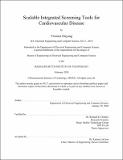Scalable integrated screening tools for cardiovascular disease
Author(s)
Ouyang, Victoria(Victoria S.)
Download1237530247-MIT.pdf (11.60Mb)
Other Contributors
Massachusetts Institute of Technology. Department of Electrical Engineering and Computer Science.
Advisor
Richard R. Fletcher.
Terms of use
Metadata
Show full item recordAbstract
Cardiovascular disease (CVD) is the leading cause of mortality worldwide, accounting for more than 17.9 million deaths per year. Atherosclerosis, characterized by stiffening of the arteries, is the precursor to heart attacks and strokes, which cover 85% of all CVD mortalities. Since the disease is largely asymptomatic, a major challenge remains in screening for at-risk individuals. Existing screening tools primarily rely on questionnaires which do not account for ethnicity and require blood pressure and cholesterol readings. Thus, there is a crucial need for low-cost, non-invasive screening tools, especially in low-resource areas where people do not have access to routine clinical exams and blood tests. To address these shortcomings, this thesis presents a scalable integrated CVD screening toolkit that is practical and can be deployed in a real-world setting. We have developed Android mobile apps and hardware capable of performing pulse wave analysis (PWA) and measuring pulse wave velocity (PWV) using PPG techniques. The analysis algorithms are configured to run on a custom server that is able to handle large amounts of medical data. In this thesis, I describe the PWA and PWV algorithms, the mobile applications associated with these measurements, and their integration with a custom server. To validate these new algorithms, data was used from two separate clinical studies conducted by our group. For PWA, I analyzed PPG waveforms from young athletic people, young non-athletic people, old healthy people, and old CAD patients, which resulted in median PWA Scores of 3.51 (0.57), 3.19 (0.78), 1.98 (0.66), and 1.81 (0.5) respectively. From these results, the PWA tool demonstrated sufficient sensitivity to distinguish between the four different cardiovascular health classifications. Based on a larger clinical study with 100 subjects at the Sengupta Hospital and Research Institute in Nagpur, India, I found that PWV in the central artery behaves differently from the PWV in peripheral muscular arteries. The study showed that central aortic PWV is a good indicator of atherosclerosis and coronary arterial disease. Using these results, I demonstrated that our machine learning algorithm is able to reliably distinguish healthy patients from non-healthy with an AUC of 0.83 (0.18).
Description
Thesis: M. Eng., Massachusetts Institute of Technology, Department of Electrical Engineering and Computer Science, February, 2020 Cataloged from student-submitted PDF of thesis. Includes bibliographical references (pages 114-117).
Date issued
2020Department
Massachusetts Institute of Technology. Department of Electrical Engineering and Computer SciencePublisher
Massachusetts Institute of Technology
Keywords
Electrical Engineering and Computer Science.